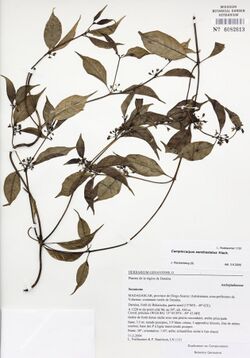Biology:Camptocarpus semihastatus
| Camptocarpus semihastatus | |
|---|---|

| |
| Photograph of a herbarium specimen of Camptocarpus semihastatus[1] | |
| Scientific classification | |
| Kingdom: | Plantae |
| Clade: | Tracheophytes |
| Clade: | Angiosperms |
| Clade: | Eudicots |
| Clade: | Asterids |
| Order: | Gentianales |
| Family: | Apocynaceae |
| Genus: | Camptocarpus |
| Species: | C. semihastatus
|
| Binomial name | |
| Camptocarpus semihastatus Klack.
| |
| Synonyms[3] | |
| |
Camptocarpus semihastatus is a species of plant in the Apocynaceae family. It is native to Madagascar .[4] Jens Klackenberg,[5] the botanist who formally described the species named it after the distinct coronal lobes of its flowers that resemble half the head of a spear (hasta in Latin).[6][7]
Description
It is a climbing plant. Its elliptical to egg-shaped leaves are 3.5–7 by 1–3 millimeters. The tips of its leaves sometimes come to a long, tapering point. The bases of the leaves are wedge-shaped to tapering. Its petioles are 3–13 millimeters long. Its many flowered, branching Inflorescences occur at the junction between the leaves and stem. Each flower is on a pedicels that is 3–6 millimeters long. The pedicels have bracts that are 1 millimeter long. Its flowers have 5 hairless sepals that are connected at the base with broad, egg-shaped lobes that are 0.7–1 by 0.7–1 millimeters. The sepals have pointed tips. The 5 hairless, white to rose-colored petals are fused at their base to form a 0.8–1.2 millimeter tube with oblong lobes that are 2.8–3.4 by 1.1–1.6 millimeters. The petals have rounded tips. The flowers have a ring-like structure between the petals and its stamen called a corona. Its corona has 5 thread-like lobes that are 2–3 millimeters long with appendages at the top that point inwards. Its stamen have very short, 0.1 millimeter-long, filaments and 0.5–0.6 millimeter long anthers. The anthers have a recurved appendix at their base. The connective tissue between the chambers of the anther extends up into a rounded tip. Its pistils have broad, cone-shaped stigma.[2][7]
Reproductive biology
The pollen of Camptocarpus linearis is shed as permanent tetrads.[8]
Distribution and habitat
It has been observed growing in forest and shrub habitats at elevations of 500 to 1499 meters.[2][7]
References
- ↑ "Camptocarpus semihastatus Klack.". Tropicos.org. Missouri Botanical Garden. n.d.. https://www.tropicos.org/name/50120287.
- ↑ 2.0 2.1 2.2 Missouri Botanical Garden (2018). "Camptocarpus semihastatus". IUCN Red List of Threatened Species 2018: e.T70102267A70123430. doi:10.2305/IUCN.UK.2018-2.RLTS.T70102267A70123430.en. https://www.iucnredlist.org/species/70102267/70123430. Retrieved August 1, 2023.
- ↑ "Camptocarpus semihastatus Klack.". Species 2000. n.d.. https://www.catalogueoflife.org/data/taxon/QF7Z.
- ↑ "Camptocarpus semihastatus (Decne.) Klack.". The Trustees of the Royal Botanic Gardens, Kew. n.d.. https://powo.science.kew.org/taxon/urn:lsid:ipni.org:names:1000708-1.
- ↑ "Jens Klackenberg". International Plant Names Index (IPNI). Royal Botanic Gardens, Kew. https://www.ipni.org/a/21474-1.
- ↑ Stearn, William (2004). Botanical Latin. Portland, Ore. Newton Abbot: Timber Press David & Charles. ISBN 9780881926279.
- ↑ 7.0 7.1 7.2 Klackenberg, Jens (1998). "Taxonomy and phylogeny of the genus Camtocarpus s.l. (Periplocoideae, Asclepiadaceae)". Botanische Jahrbücher für Systematik, Pflanzengeschichte und Pflanzengeographie 120: 45-85.
- ↑ Verhoeven, Rudolf L.; Venter, Johan T. (2001). "Pollen Morphology of the Periplocoideae, Secamonoideae, and Asclepiadoideae (Apocynaceae)". Annals of the Missouri Botanical Garden 88 (4): 569-582.
Wikidata ☰ Q15396595 entry
 |


